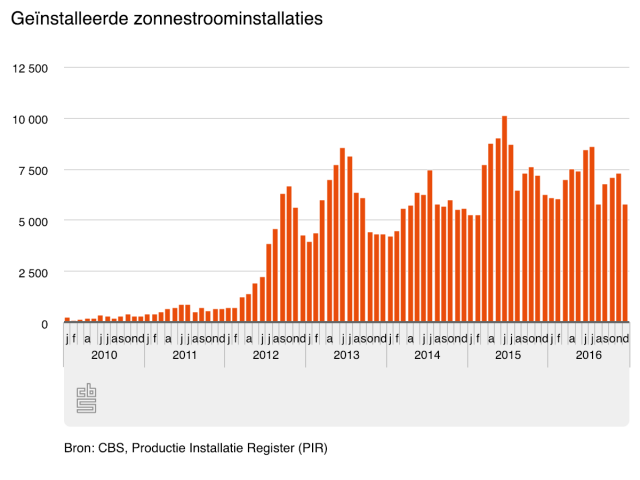Why solar power?
Solar energy is an inexhaustible source of energy. It is clean and never runs out. The amount of energy is truly gigantic: per minute the earth captures more energy from the sun than we consume per year worldwide in energy.
Even in the winter when it is a bit colder, the sun still gives enough energy to make use of. Unfortunately, the techniques for actively using solar energy are often relatively expensive. The higher cost of a solar water heater compared to a (central) heating boiler is recovered after about five to twelve years through savings on your energy use. This is also dependent on the use. There is also the heat pump.
Solar panels, on the other hand, are dropping rapidly in price and are made of silicon, which in turn is made of sand. This is abundantly available on earth. And with production rising rapidly, the cost per panel has been falling for years. In September 2018, import duties on Chinese solar panels were even removed so the price is falling even faster.
Availability of solar energy
Solar energy, like wind energy, is not always one hundred percent available. The intensity of the sun’s available energy fluctuates with the seasons. In summer, the sun gives off more energy per square meter than in winter. But there are also intensity differences in the shorter term, for example when it is cloudy. As a result, the performance of solar systems also fluctuates. What types of solar energy are there?
Passive
Passive use of solar energy means using incoming sunlight without the need for devices. This mainly relates to the heat management in buildings and homes, but also the incident light. Using passive solar energy can save a considerable amount of energy. Some passive solar energy measures:
- Large windows on the south side and smaller windows on the north side of a house/building;
- Solar shades around the house/building
- Solar shades to prevent overheating in the summer;
- Good insulation around warm rooms;
- Reconfiguration (warm spaces such as living room on the south side, colder – less used – spaces on the north side).
Active
Solar photovoltaic (PV) systems convert solar radiation directly into electricity. The systems consist of solar panels, containing a collection of solar cells linked together. This is similar to what plants do, they just don’t convert sunlight into electricity, but into chemical energy.
The solar cells are connected in series to provide a usable voltage. And solar panels are also coupled in series to provide a usable voltage that inverters convert from direct current to alternating current. You can also use solar collectors to preheat water, before the water is delivered to the boiler. This saves gas which we want to get rid of as soon as possible in the Netherlands.
Yields of solar panels in the Netherlands
Currently (2020) there are about 24 million panels installed in the Netherlands and this amount is still increasing rapidly. Growing environmental awareness, falling prices of solar panels and low interest rates ensure rapid growth. Together, these panels account for 7,000 MWpik. That is 5% of the total electricity production in the Netherlands.
If all available space for PV panels in the Netherlands is used, the Netherlands can meet 75% of its energy needs. Energy Research Centre of the Netherlands (ECN) expects that now the application of solar energy really starts to take off, the cost price of usable energy from the sun has gone down and even become lower than the cost price of the increasingly expensive conventional energy. This is partly because the price of CO2 is rising and with it the price of conventional power generation.
What can solar energy be converted to?
Solar energy can be used very well in built-up areas where energy – both electricity and heat generation – is needed. This is because solar energy is a quiet, quite maintenance-free type of energy that produces virtually no visual pollution. Solar panels for electricity and solar collectors for hot water. Applying for a permit is usually not necessary, but you must report the installation to your municipality at the building and housing supervision department.
Tips
Below you can find some tips for buying panels:
Please note: the video says that the net metering scheme will expire in 2020. This has since become 2023.


